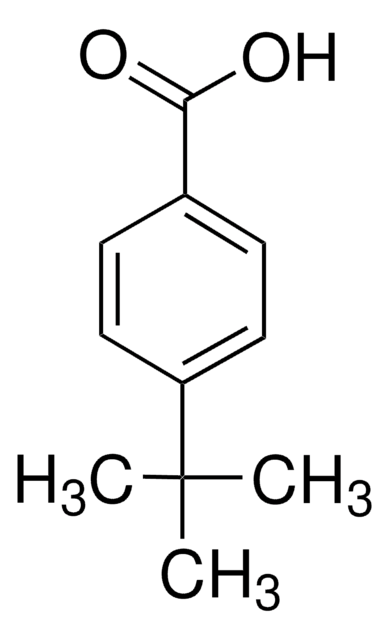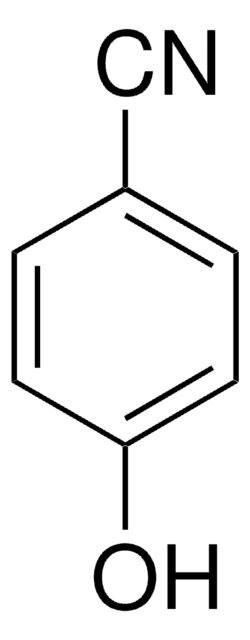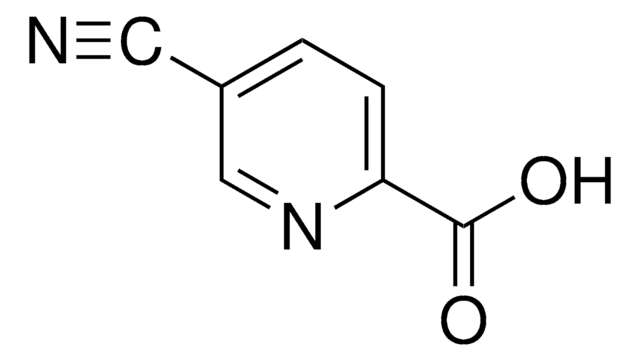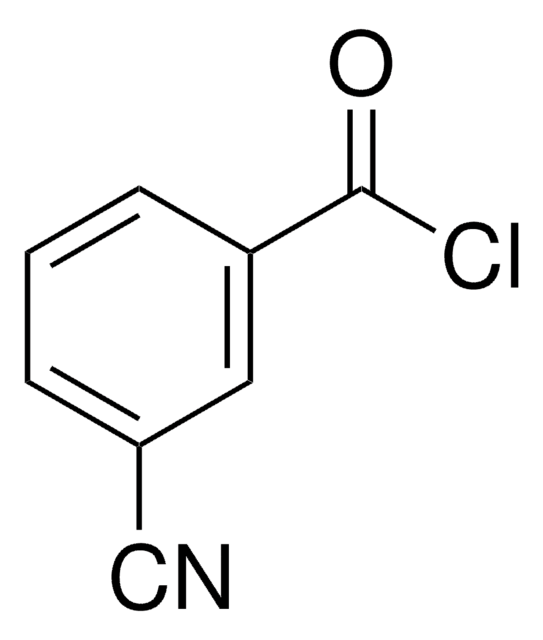C89803
4-Cyanobenzoic acid
99%
Synonym(s):
Terephthalic acid mononitrile
Sign Into View Organizational & Contract Pricing
All Photos(1)
About This Item
Linear Formula:
NCC6H4CO2H
CAS Number:
Molecular Weight:
147.13
Beilstein:
1862865
EC Number:
MDL number:
UNSPSC Code:
12352103
PubChem Substance ID:
NACRES:
NA.23
Recommended Products
Assay
99%
form
liquid crystal
mp
219-221 °C (dec.) (lit.)
SMILES string
OC(=O)c1ccc(cc1)C#N
InChI
1S/C8H5NO2/c9-5-6-1-3-7(4-2-6)8(10)11/h1-4H,(H,10,11)
InChI key
ADCUEPOHPCPMCE-UHFFFAOYSA-N
Looking for similar products? Visit Product Comparison Guide
Related Categories
Signal Word
Warning
Hazard Statements
Precautionary Statements
Hazard Classifications
Eye Irrit. 2 - Skin Irrit. 2 - STOT SE 3
Target Organs
Respiratory system
Storage Class Code
11 - Combustible Solids
WGK
WGK 3
Flash Point(F)
Not applicable
Flash Point(C)
Not applicable
Personal Protective Equipment
dust mask type N95 (US), Eyeshields, Gloves
Choose from one of the most recent versions:
Already Own This Product?
Find documentation for the products that you have recently purchased in the Document Library.
Customers Also Viewed
Wan-Yin Fang et al.
Chemistry, an Asian journal, 12(17), 2323-2331 (2017-07-13)
A one-pot Pd-catalyzed carbonylation of phenols into their corresponding aryl carboxylic acids and esters through the insertion of carbon monoxide has been developed. This procedure offers a direct synthesis of aryl carboxylic acids and esters from inexpensive and abundant starting
Matthew Noestheden et al.
Bioorganic chemistry, 35(3), 284-293 (2007-02-24)
A recombinant VH single-domain antibody recognizing staphylococcal protein A was functionalized on reactive lysine residues with N-hydroxysuccimidyl-activated 4-cyanobenzoate. Surface plasmon resonance analysis of antibody-antigen binding revealed that modified and unmodified antibodies bound protein A with similar affinities. Raman imaging of
V Arjunan et al.
Spectrochimica acta. Part A, Molecular and biomolecular spectroscopy, 78(5), 1449-1454 (2011-02-26)
The Fourier transform infrared (FTIR) and FT-Raman spectra of p-cyanobenzoic acid (CBA) have been recorded in the range 4000-400 and 4000-100 cm(-1), respectively. The complete vibrational assignment and analysis of the fundamental modes of the compound were carried out using
Lisa A Hoferkamp et al.
Environmental science & technology, 40(7), 2206-2212 (2006-05-02)
The reductive transformation of p-cyanonitrobenzene (pCNB) was investigated in laboratory batch slurries exhibiting dominant terminal electron accepting processes (TEAPs). Pseudo-first-order rate constants (k(obs)) were measured for the reduction of pCNB in nitrate-reducing, iron-reducing, sulfate-reducing, and methanogenic sediment slurries. Reduction was
P Boudeville et al.
Journal of pharmaceutical sciences, 84(9), 1083-1089 (1995-09-01)
A new methodology of pH-metric data treatment was developed to extract the stoichiometry and the thermodynamic association constants of guest-cyclodextrin inclusion complexes in dilute aqueous solution when the guest is a participant in an acid-base equilibrium. pH-metric titration curves in
Our team of scientists has experience in all areas of research including Life Science, Material Science, Chemical Synthesis, Chromatography, Analytical and many others.
Contact Technical Service

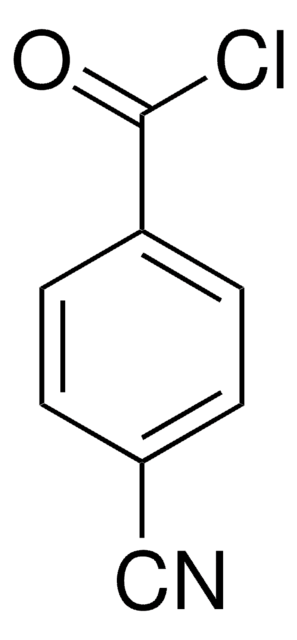


![1,8-Diazabicyclo[5.4.0]undec-7-ene 98%](/deepweb/assets/sigmaaldrich/product/structures/120/564/5b373e23-1624-489c-8efb-692de0f96ffb/640/5b373e23-1624-489c-8efb-692de0f96ffb.png)

